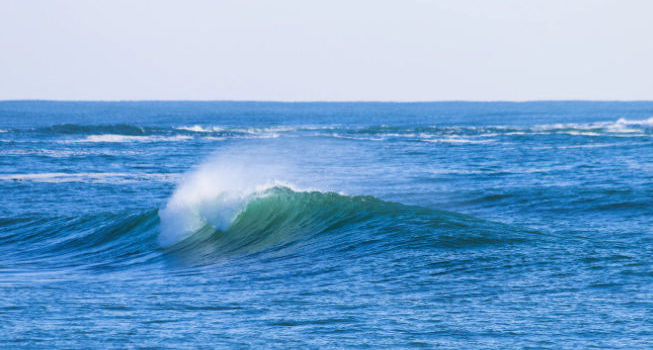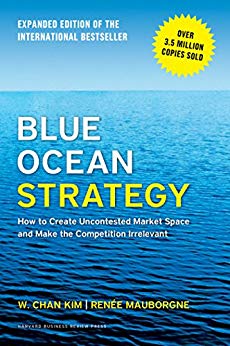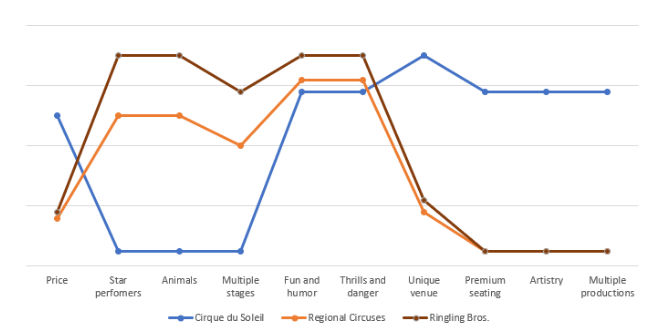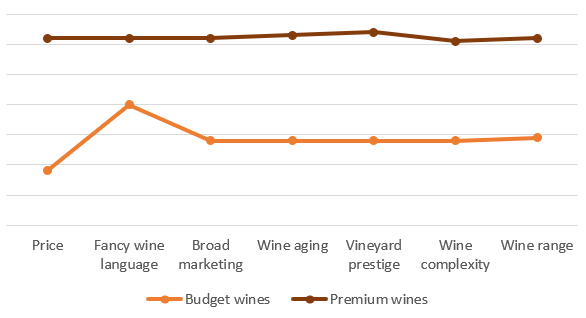

This article is an excerpt from the Shortform summary of "Blue Ocean Strategy" by W. Chan Kim and Renee Mauborgne. Shortform has the world's best summaries of books you should be reading.
Like this article? Sign up for a free trial here .
The strategy canvas is an important analytical tool from Blue Ocean Strategy. How do you use it in your business strategy to illustrate how your company differs? Learn more about the strategy canvas here.
Strategy Canvas Introduction
The strategy canvas from Blue Ocean Strategy visualizes the current state of the industry and shows how a blue ocean strategy differs from incumbents. It plots two axes:
- On the horizontal axis: List the factors the customer cares about, and current dimensions of competition.
- On the vertical axis: Segment buyers into distinct groups. For each group, plot a value curve showing how much buyers receive in each of the factors.
The goal of a blue ocean strategy is to deliver more of what customers value (thus offering a clearly better product), and less of what they don’t (thus saving costs). The strategy canvas makes this clear.
Strategy Canvas: Cirque du Soleil
Circuses in the 1980s were dominated by Ringling Bros. and Barnum & Bailey. They featured three-ring circuses, clowns, and animal acts, and their customers were children and families.
However, competition was fierce. Circuses competed to secure more famous entertainers and exotic animal acts, raising costs without dramatically changing buyer value. Buyers had appealing substitutes for entertainment in television and video games. Furthermore, there was increasing public outcry about confinement and harsh training of animals.
A former street performer, Guy Laliberté decided to escape the red ocean of circuses to create a blue ocean of theatrical entertainment: Cirque du Soleil. Its shows combine the circus with adult theater, showing incredible acrobatics and physical feats set to a storyline and original music.
Here’s a canvas of Cirque du Soleil vs Ringling Bros and smaller regional circuses:

Notice how smaller regional circuses are simply lower-cost imitations of the big names. Smaller circuses compete largely on the same dimensions, but executes less well and commands a lower price.
Now look at where Cirque du Soleil differs drastically, and where it offers similar value.
- It cut down on costly expenses that didn’t provide customer value – star performers and animal shows.
- Cirque du Soleil’s shows featured similar acrobatic wonderment and thrill as circuses.
- It introduced entirely new elements like high production value and artistry, which were important to their customers but completely absent from normal circuses.
This strategy canvas clearly shows how Cirque du Soleil offered superior customer value while lowering certain costs.
Warning Signs of Bad Strategy Canvases
When you plot your strategy canvas from Blue Ocean Strategy, there are two warning signs of bad strategies:
- When your value curve on the strategy canvas closely resembles those of competitors. This suggests you’ll be competing directly with them, offering at best incremental value or cost savings. Red ocean competition looks like this.
- When you try to offer extremely high value on all dimensions on your strategy canvas. In this case, you’re trying to be something for everyone, making it compelling for no one and delivering a worse experience than a focused competitors. It’s very unlikely that all customer segments care equally about all values. Force yourself to question assumptions about what customers value, and try to separate customers into different segments.
Also, when you build your value curve, it’s tempting to list values that superficially differentiate you from competitors, but offer little value to your customers (Shortform examples: a re-designed website; telephone support when your customers don’t use it). It’s important to list the values that your customers truly care about.
Strategy Canvas: Casella Wines and [yellow tail]
In the 1990s, wine in the United States occupied two segments: high value fancy wines vs mass-produced budget wines. Fancy wines tried to offer more of everything – tasting complexity, refined image, aging, vineyard history and prestige, and price. Budget wines simply offered less of everything. Here’s their strategy canvas:

Even though 1,000+ premium wineries tried to differentiate from each other, they were strategically very similar. To customers, they were largely all different from box wines in the same way.
The Australian firm Casella Wines examined the wine industry from a different perspective: how do you make wine that’s easy to drink and fun? Wine alternatives like beer and spirits accounted for the majority of sales, so clearly most Americans saw wine as a turn off. It was intimidating and pretentious.
Learn how yellow tail wines used blue ocean strategy to upend the wine industry.
Develop Your Strategy Canvas Effectively
Now that you know how to find blue ocean opportunities, the first implementation step is to draw your strategy canvas, which we covered in Chapter 2. This simple visual clearly situates your previous and new strategy in the context of the overall industry and provides an easy-to-understand rallying cry for all levels of the company.
To review, a strategy canvas accomplishes the following:
- It identifies the important factors of competition in the industry
- It shows the strategic profile of current competitors, including your company
- It shows how a new blue ocean strategy creates a unique value curve, focusing on values critical to customers at the expense of less-important factors
The strategy canvas gets you to focus on big-picture strategic items, rather than getting mired in numbers, spreadsheets, and incremental improvements.
Here is a summary of how to generate and develop strategy canvases, step by step:
1. Visual awakening
- Goal: Agree on the current state of the industry and how your company fits in. Overcome denial about your company’s current position.
- Draw the strategy canvas of your industry and your current strategy
- Consider creating separate teams to highlight different opinions on competition factors
- See where your strategy needs to change
- Notice where your org has lost focus, is spread thin, or resembles the exact strategy of competitors
- Notice where a competitor may have a clearly differentiated strategy
2. Visual exploration
- Goal: See customer problems in person for inspiration on new offerings.
- Go directly to customers, non-customers, lost customers, and competitors’ customers to evaluate the 6 paths to creating blue oceans (from chapter 3)
- Talk to people. Watch them in action.
- Find which factors they care a lot about. Find which factors they couldn’t care less about. At least a few of your assumptions are probably wrong.
- Try alternatives to your product to find new factors your product doesn’t have
- Draw a range of new strategy canvases
- Decide which factors you will eliminate, reduce, raise, or create
- Force people to create multiple canvases to push thinking. Consider creating one canvas for each of the six paths.
3. Visual presentation
- Goal: Seek input on your strategy canvases. Find good attributes of multiple strategies to build stronger strategies.
- Present canvases to stakeholders, including not just management but also employees, customers, noncustomers
- Limit presentations to 10 minutes – any longer and the strategy is too complicated
- Judges award stickers to their favorites. They explain their picks and also their non-picks
- Find commonalities between strategy curves. Different teams may arrive through different data sources at the same factors that customers care about
- End by synthesizing a value curve for the new strategy
———End of Preview———

Like what you just read? Read the rest of the world's best summary of "Blue Ocean Strategy" at Shortform . Learn the book's critical concepts in 20 minutes or less .
Here's what you'll find in our full Blue Ocean Strategy summary :
- What blue oceans are, and how you create one for your business
- Why some businesses succeed in creating blue oceans, and why others fail
- The red ocean traps you have to avoid if you want business growth






